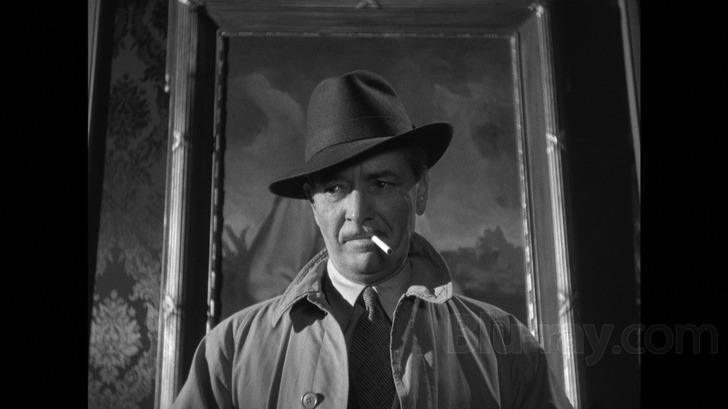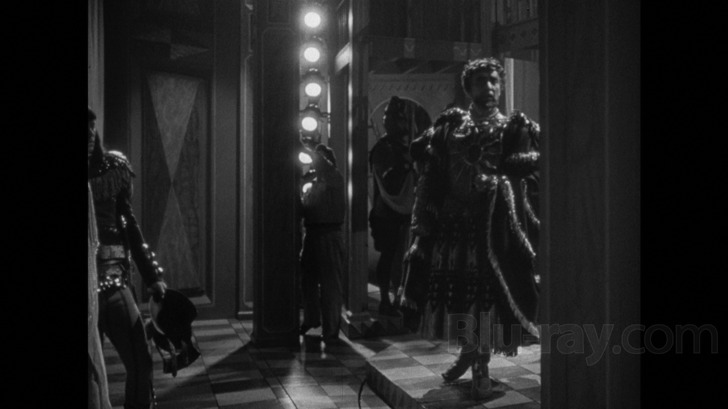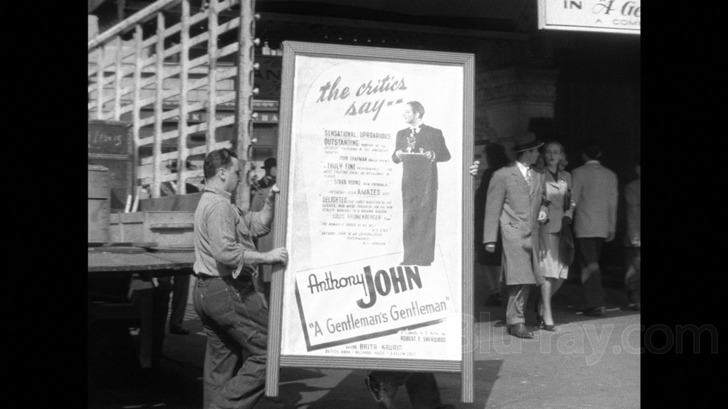A Double Life Blu-ray Movie
HomeA Double Life Blu-ray Movie 
Olive Films | 1947 | 105 min | Not rated | Sep 18, 2012Movie rating
7.3 | / 10 |
Blu-ray rating
| Users | 4.2 | |
| Reviewer | 4.0 | |
| Overall | 4.0 |
Overview
A Double Life (1947)
Anthony John is an actor whose life is strongly influenced by the characters he plays. When he's playing comedy, he's the most enjoyable person in the world, but when he's playing drama, it's terrible to be around him. That's the reason why his wife Brita divorced him; although she still loves him and works with him, she couldn't stand living with him anymore. So when Anthony accepts to play Othello, he devotes himself entirely to the part, but it soon overwhelms him and with each day his mind gets filled more and more with Othello's murderous jealousy.
Starring: Ronald Colman, Edmond O'Brien, Signe Hasso, Shelley Winters, Ray Collins (I)Director: George Cukor
| Film-Noir | Uncertain |
| Thriller | Uncertain |
| Crime | Uncertain |
| Drama | Uncertain |
Specifications
Video
Video codec: MPEG-4 AVC
Video resolution: 1080p
Aspect ratio: 1.35:1
Original aspect ratio: 1.37:1
Audio
English: DTS-HD Master Audio Mono (48kHz, 16-bit)
Subtitles
None
Discs
25GB Blu-ray Disc
Single disc (1 BD)
Packaging
Slipcover in original pressing
Playback
Region A, B (C untested)
Review
Rating summary
| Movie | 4.0 | |
| Video | 4.0 | |
| Audio | 3.0 | |
| Extras | 0.5 | |
| Overall | 4.0 |
A Double Life Blu-ray Movie Review
Role playing.
Reviewed by Jeffrey Kauffman September 14, 2012There are some actors who so completely merge with their roles that the actor becomes subsumed by the character. Think of Marlon Brando is in heyday, or Meryl Streep in or out of a dialect, to give just two examples. On the other hand, some actors tend to portray themselves more or less in every role, and often serve mostly as types rather than full bodied characters, at least a lot of the time (Cary Grant—aside from rare roles like None But the Lonely Heart—springs instantly to mind). But some actors become so involved in their roles that they blur the lines between reality and artifice. Many of these actors are routinely pilloried in the press for “staying in character” between takes and the like, but A Double Life’s conceit is that its leading player (in every sense of the word), Broadway star Anthony John (Ronald Colman), has so confused playing with being that he can’t tell the difference any more on any meaningful level. A Double Life is a rather interesting film in director George Cukor’s oeuvre. As Martin Scorsese mentions in his brief but illuminating introduction to the film, Cukor was the quintessential “women’s director,” one of the reasons that Vivien Leigh and Olivia de Havilland were so distraught when Cukor was yanked from Gone With the Wind and replaced by “man’s man” Victor Fleming (some say in an attempt to appease Clark Gable). That potentially devastating career setback was hardly a blip on the screen in Cukor’s long and lauded career, but few might have expected him to try his hand at a kind of noir-esque film set in the hoity toity world of Broadway. A Double Life wants to co-exist as both a darkly shaded mystery and a backstage drama illuminating the egos and eccentricities of actors. Due to some very smart writing by stage and screen icons (and couple) Garson Kanin and Ruth Gordon, against some considerable odds, A Double Life succeeds rather well.

For younger audiences, Ruth Gordon is probably most associated with two iconic film roles from her latter day career, Minnie Castevet in Rosemary's Baby (for which she won a well deserved Academy Award for Best Supporting Actress) and Maude in Harold and Maude. What many who enjoyed Gordon’s elderly acting performances may not have realized is that Gordon had had an impressive prior career both on stage and especially as a writer, often with her spouse of over 40 years, Garson Kanin. Gordon and Kanin’s first film collaboration was in fact A Double Life, which brought the pair their first Academy Award nomination for their writing. They would go on to pen two of the best loved films featuring their close friends Katharine Hepburn and Spencer Tracy, Pat and Mike and Adam’s Rib, earning two more Academy Award nominations for those efforts as well (both of those films were directed by A Double Life’s helmsman George Cukor, too). Gordon and Kanin were both highly literate writers, ebullient and at times close to being snarky, which is what makes A Double Life such a bracing experience. While there is undeniable wit here, especially in little sequences like the opening gambit where we get a whole host of differing opinions about the true character of Anthony John, the film has a brooding, menacing presence which seems distinctly at odds with the writing pair’s more lighthearted fare.
What Gordon and Kanin do (mostly) effortlessly here is portray the fragility of an actor’s ego, a precariously perched sense of self that is swathed in bravado but which is in actuality a morass of insecurity and rage. Rather remarkably, Colman, one of the most effete, patrician actors to ever grace film, rises to the occasion with a blisteringly visceral performance. In fact it’s due largely to how suave Colman undeniably is that his eruptions into madness and violence are so shocking. Anthony John’s descent into madness may not be especially well developed—there are hints that he’s had a history of violence with his ex-wife Brita (Signe Hasso)—but that almost isn’t that relevant under the harsh stage lights of Colman’s brilliantly energetic performance.
While elements of A Double Life echo a kind of quasi-Grand Guignol aesthetic, and Cukor and cinematographer Milton R. Krasner aren’t especially subtle at times, offering scene after scene with mirrors (just in case the viewer doesn’t get the “double” reference) and some hoary clichés supposedly illuminating John’s mental breakdown, the film has a real power and disturbing qualities. Shelley Winters plays an ambitious waitress cum sex kitten named Pat, and her relationship with John plays well into the film’s dual theses of “everyone has an angle” (Pat may in fact be enamored of John, but she also senses he’s a decided rung on the ladder of success) and the frailty of the actor’s psyche (John may run to Pat after thinking his ex-wife has found a new romance, but he can’t follow through on his most carnal desires).
Rather strangely considering Gordon and Kanin’s literary proclivities, the film plays pretty fast and loose with its Othello elements, and in fact the “play within a play” aspect will probably strike modern day viewers as the corniest aspect of the film. One of the more interesting aspects, though, is framed through the writers’ summation of “sense memory” and the burgeoning technique which would soon blast across screens of the fifties and become immortalized as The Method. A Double Life exposes the risk of an actor utilizing his own life experiences to inform a role with veracity and the immediacy of “real” emotion: his life and the life of his character become inextricably intertwined and in the case of an actor like Anthony John, a man with a roiling emotional tempestuousness and an unbalanced mind, two “heads” merging into one spells utter ruin.
A Double Life Blu-ray Movie, Video Quality 

A Double Life is presented on Blu-ray courtesy of Olive Films with an AVC encoded 1080p transfer in 1.35:1. This is another lustrous looking black and white transfer from Olive, one which for the most part offers a crisp and involving image, one with superior contrast, excellent (if sometimes quite thick) grain structure, and deep blacks, well modulated gray scale and bright whites. Cinematographer Milton R. Krasner bathes this film in shadows, with a lot of the film playing out in dim lighting, and the chiaroscuro effect is rendered with excellence and very good shadow detail here. There are a couple of head scratching moments, however, with a suddenly softer image and completely blown out contrast. A good example is captured in the ninth screencap accompanying this review of two women walking down a busy Manhattan street. This whole sequence is noticeably softer and with much poorer contrast than the bulk of the film. There are a couple of other very minor issues with the elements (see the tiny scratch over Edmond O'Brien's head in the screencap of him typing), but overall this is another fantastic release from Olive.
A Double Life Blu-ray Movie, Audio Quality 

A Double Life features a lossless DTS-HD Master Audio Mono track which sports decent fidelity but which unfortunately also has some minor distortion in the midrange, something that is especially unfortunate since it affects some of Miklos Rozsa's Oscar winning score, especially string cues that have sudden dynamic changes. Otherwise, though, the track sounds relatively nimble, with most of the dialogue presented cleanly and clearly (occasionally Colman tends to sound a bit jumbled for some reason). Other than the distortion issue, there really isn't any major damage to report.
A Double Life Blu-ray Movie, Special Features and Extras 

- Introduction by Martin Scorsese (SD; 2:49). This is another brief but insightful overview offered by the iconic director. Scorsese discusses the film's rather odd blending of genres as well as some of the film's notable techniques.
A Double Life Blu-ray Movie, Overall Score and Recommendation 

A Double Life is a bit creaky at times, but it also has one elegantly menacing performance at its core which helps to elevate the film above its kind of B-movie ambience. The Broadway setting is not exactly realistic, and veers between being too glamorous or too silly, but Gordon and Kanin make some interesting points about an actor's life and those who escape reality by disappearing into their roles. This is certainly a kind of odd feature for George Cukor, but he invests the film with some requisite moodiness, if no real terror. This Olive release boasts exceptional image quality and at least adequate audio quality, and the Scorsese introduction is a valued, if awfully minimal, supplement. Recommended.
Similar titles
Similar titles you might also like

Naked Alibi
1954

Cry Vengeance
1954

Cry Danger
1951

Beyond a Reasonable Doubt
1956

Hollow Triumph
The Scar
1948

High Sierra
1941

Across the Hall
2009

Hell on Frisco Bay
1955

Kiss the Blood Off My Hands
1948

Panic in the Streets
Fox Studio Classics
1950

The Killer That Stalked New York
1950

The Night Holds Terror
1955

The Big Combo
1955

The Glass Key
1942

One Way Street
1950

Shakedown
1950

Six Bridges to Cross
1955

Finger Man
1955

Down Three Dark Streets
Down 3 Dark Streets
1954

Try and Get Me!
The Sound of Fury
1950
